Located in the heart of In the heart of the city, the castle of Nantes is the architectural witness of 6 centuries of History. A landmark in the history of 16th-century Brittany, the château now houses an astonishing museum of the history of Nantes.
The castle of Nantes is also called castle of the Dukes of Brittany (château des ducs de Bretagne) or castle of Anne of Brittany, but we will come back to it later in this article.
Prepare your visit to the castle of Nantes with this article: advice on the direction of the visit, map and our favorites not to be missed!
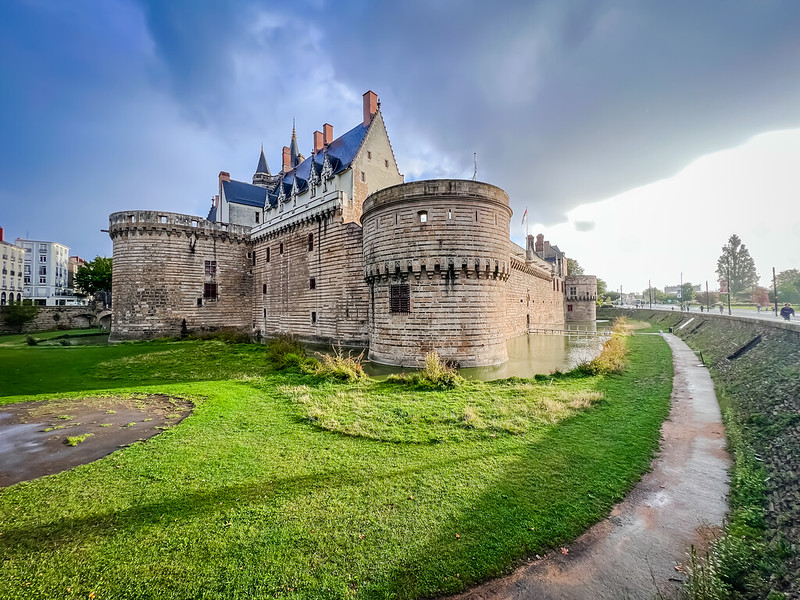
This guide is completely independent, based on our experiences. We visited the region anonymously, making our own choices and paying our bills in full.
Why visit the Nantes castle (château de Nantes)?
Is the castle of Nantes worth it? Our opinion:
The castle of Nantes is remarkable in more than one way:
- For the variety of its architecture: from 15th-century defensive structuresto Renaissance palaces, not forgetting the grand staircase inherited from Louis XIV, the Château de Nantes is a real plunge into the history of French architecture.
- For its historical interest: marked by Anne of Brittany, only queen married successively to 2 kings of France, the castle of Nantes is the place of the signature of the definitive attachment of Brittany to the crown of France in 1532.
- For its museum of the History of Nantes: a surprising museum with a particularly careful scenography, which will take you from the great maritime epics to the contemporary history of the city, without forgetting the dark hours of the city, in particular the slave trade.

Why is the Château de Nantes famous?
The castle of Nantes is famous for having been the "castle of Anne de Bretagne".

Daughter of the Duke of Brittany, François II, who had the new castle of Nantes built, she made a considerable mark on French history. Promised and betrothed by her father to no fewer than 7 European princes (the first time, when she was just 4), she married Maximilian I of Hasburg, emperor of the Holy Roman Empire, by proxy in 1490. The king of France seeing a threat, he besieged the city of Rennes and Anne of Brittany was finally married by the grace of a treaty of Peace between Brittany and France, to Charles VIII, king of France, on December 6, 1491.

After his accidental death in the castle of Blois, she married his successor and cousin, Louis XII on December 6, 1491. Provided for in the marriage contract, this provision was intended to guarantee peace between Brittany and the Kingdom of France. Anne of Brittany is the only Queen to have married 2 successive kings of France!
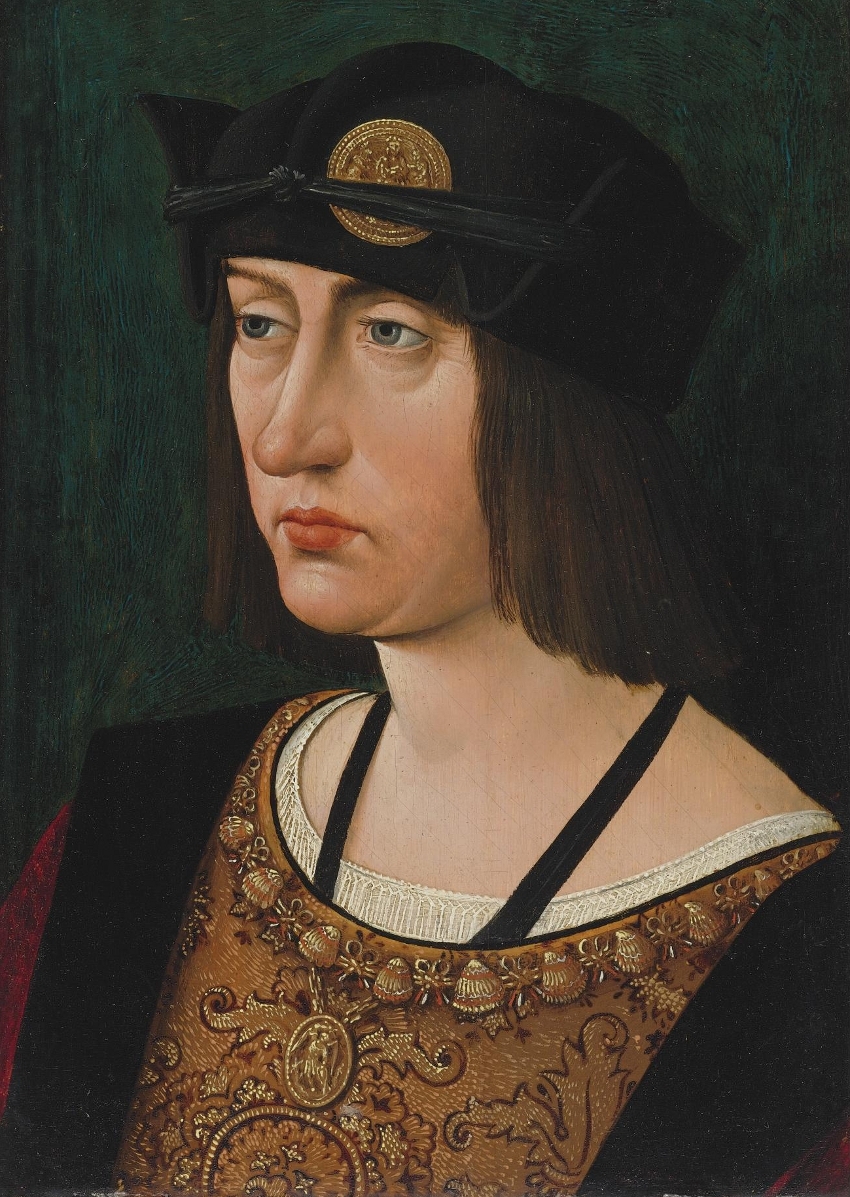
His motto reflects his commitment to his beliefs, "Potius mor quam foedari" (Rather die than dishonor).
Even though she rarely resided at the Château de Nantes, she completed the work begun by her father, furnished it richly (woodwork, tapestries...) and brought the grand dwelling into the Renaissance period.
WHERE TO STAY IN Nantes
Downtown
Would you like to sleep in the heart of Nantes and enjoy its invigorating vitality? We liked it:
- Blu Radisson Hotel - see our article - see photos prices and availability
- L'Oceania - hotel de France - see our article - see photos prices and availability

Near the station
A train to catch at dawn, there's a truly magical address just 2 steps from Nantes train station:
- Le Sozo Hotel - see our article - see photos, prices and availability

On the banks of the Erdre
Looking for a bit of peace and quiet, without straying too far from the city of Nantes? 2 addresses on the banks of the Erdre river:
- La Rivière House - see photos, prices and availability
- Le Best Western Plus Hôtel de la Régate - view photos, prices and availability

History in brief
- Môyen-Age: a first castle, known as"de la Tour Neuve", was built in the 13th century, and you can still see the "old keep" inside the castle's current courtyard. Nantes became one of the places of residence of the Dukes of Brittany.

- Renaissance: In 1460, François II ordered the construction of the new castle of Nantes which will mark the transition between the medieval and renaissance periods. His daughter, Anne of Brittany, will make it definitively enter the renaissance.
- Revolution: abandoned by the Kings of France, the castle of Nantes becomes successively prison and barracks. While it passed through the French Revolution without damage, it was partially destroyed by the accidental explosion of a powder reserve on May 25, 1800.
Tips & map: castle of the Dukes of Brittany (Châteua des Ducs de Bretagne)
Where is the Castle of Nantes
- It is located in the city of Nantes
- Driving time from Tours: 2 h 00
- Driving time from Angers: 1 h 10
- Driving time from Blois: 2 h 50
- Driving time from Orleans: 3 h 30
The map
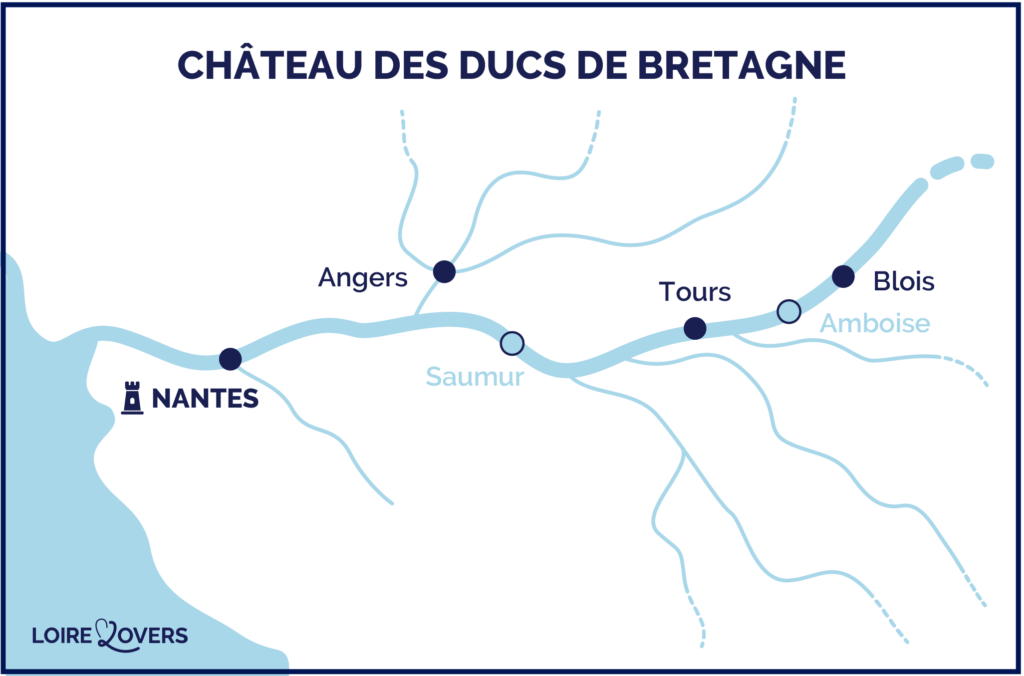
How to get there
Nantes is a city well served with its international airport, very close to the city center.
The city also has a TGV station that offers 20 shuttles per day to Paris, for an average travel time of 2 hours and 10 minutes. To connect Angers and Nantes, count 40 minutes and 2 hours for Tours.
Book your train now.

The castle of Nantes is accessible by public transport:
- Tramway > line 1
- Busway > line 4 Stop Duchesse Anne
- 10 minutes walk from the Nantes train station
OUR TIPS FOR RENTING A CAR IN Loire
- Compare prices on our preferred platform: DiscoverCars - one of the best rated sites.
- Choose a fairly compact car (many villages have narrowed the road).
- Think aboutfull insurance (parking in big cities is really tight).
- There is a lot of demand, book it early.
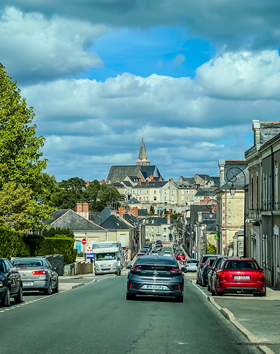
By opting for a city pass, you will have unlimited access to the city's well-developed public transport network and to 50 free services (museums, visits, cruises, etc.). We strongly recommend that you buy it in advance to avoid wasting time on site and queuing. See conditions and book your City pass.
Parking
Parking in the nearby streets is difficult and expensive, so we do not recommend venturing out to the immediate vicinity of the castle by car. 2 parking lots are located less than 10 minutes away on foot, the "Gare-Château" parking lot and the Feydeau parking lot .

The city has a good network of bicycle parking and electrical stations.
Best time to visit the Chateau de Nantes
The castle of Nantes is vast and all the buildings are freely accessible. There is little risk of queuing or congestion, but we strongly advise you to buy your ticket in advance. Only the museum part is not free.
Also, apart from special events (heritage day, temporary exhibition...), the castle is quite easy to visit. If you really want to be quiet, choose the beginning of the day. Also pay attention to the end-of-year school trips (May and June).
How long and main difficulties
Duration of visit:
- 1 hour and a half to walk around the covered way and take the time to admire the different buildings of the castle.
- 1 hour minimum for the museum, 3 hours for a complete tour.
Main difficulties:
- The floor is in good condition but paved.
- Some steep steps to access the beginning of the guard tower and some steps along the curtain walls, especially in the covered areas.

PMR access
Constant attention has been paid to theaccessibility of the premises, especially in the museum part (28 rooms out of 32 accessible at the cost of a few detours, but really bravo for this work in a listed building of the 15th century).
For the castle part, the courtyard is accessible, as well as a part of the ramparts, enough to get an idea.
A specific guide is available here.
Map of the Castle of Nantes

Advice on how to visit
Understanding the castle of Nantes is not always easy, as it looks like an architectural puzzle. We'll take the time to give you our bench marks to help you find your way around.
Note also that only the exteriors are open to visitors, unlike the majority of Loire castles, the interior being dedicated to the Museum of the History of Nantes and presenting almost no architectural interest (except for the view of the interior of the loggias).
We recommend the following direction of visit :
- before returning, go around (at least partially) the moat of the castle to appreciate the volume of the castle and its defensive structures (towers, walls and curtains).

- Before crossing the Levis bridge, take the time to admirethe "châtelet" (entrance to the castle), truly remarkable in Nantes. It is composed of 2 towers, connected by a central part which shelters the two drawbridges, surmounted by a bell tower and its weathervane (if you have good eyes, you will see engraved there, flowers of Lys and the sun of Louis XIV).

Now enter the courtyard to admire the different buildings:
- The most imposing is the living quarters, composed of 3 interconnected parts. From left to right: the great dwelling, the tower of the golden crown, the great government (recognizable by its ceremonial staircase).

- at the end of the courtyard on the left: recognizable by its conical tower which houses a spiral staircase on 4 floors, the conciergerie to which is attached the old keep inherited from the old castle of the Tour Neuve.

- in the back of the courtyard in front: the harnessing, last building built (1784). It was originally intended for the manufacture and storage of weapons and ammunition and is of no particular architectural interest.

- at the end of the courtyard on the right: the small government, also called "Logis du Roy", recognizable by its chimneys decorated with brick and slate. Visible from the courtyard, you can better appreciate them from the guard path.

- Now go up the (steep) stairs along the large dwelling, near the entrance of the museum, to reach the covered way. It allows you to go all around the castle with covered passages and curtains. You can enjoy beautiful views of the castle buildings, the various defensive towers, but also a part of the city.

- On the way back down, you can tackle the Nantes History Museum if you still have energy! The visit is done in chronological order, through 7 large sequences and the direction of the visit is well indicated.

Schedules and prices
Schedules:
- Courtyard, ramparts and moat freely accessible from 8:30 am to 7 pm every day and even 8 pm during July and August.
- Museum of the history of Nantes from 10 am to 6 pm every day and 7 pm during July and August.
- Annual site closures January 1, May 1, November 1, December 25
Museum fees :
- Full adult rate: 8 €.
- Children's rate : Free for children under 18 years old
- Family rate : 5 € for 18-25 years old
Check the latest prices/times on the official website
We recommend that you opt for the city pass which gives you free access to the castle, as well as to about fifty visits of the most important monuments of Nantes. It also offers unlimited access to the public transportation system. To avoid wasting time, we strongly recommend that you purchase it in advance. See the conditions and book your City pass.
A LITTLE MORE patience
All the photos, maps, information, good addresses to make your stay in the Loire Valley a success, will soon be gathered in a single ebook!
If you wish to be informed of the publication of our guide on the Loire, register:

Guided tours
Some guided tours are offered for adults and teenagers from 15 years old. They promise a"new look" at the castle and a "portrait of the city, along the Loire".
To reserve and know the schedule, click here.
You can also visit the castle with a professional private guide by following this link.
The castle of Nantes with your children
The castle of Nantes is not especially adapted to a young public. However, most of the visit is done outside with space to run and the difficulties are moderate.
The museum part is, for its part, much more accessible to a younger public, even if you should not aim to visit all 32 exhibition rooms! A family tour lasting one and a half hours has been concocted by the museum's teams.
The majority of the 1150 exhibits are understandable for a young audience. The staging, especially in the part relating to the two world wars, can arouse their interest.

In the penultimate sequence, a 33rd room is entirely dedicated to them, with games in the world of dragons to appeal to their 5 senses.

And as a child, we love this little poster for children, created by the association Môm'Art, which works tofacilitate the reception of families in museums!

Catering
If you are hungry during your visit and don't want to leave the castle, opt for a small pancake (normal for a castle built by Breton Dukes!) to the Strawberry field ! Very well known to the people of Nantes who enjoy weekends by the sea in Pornic, this company has made a name for itself in the world of ice cream and fruity sorbets...
If you've had pancakes for your last 3 meals, our selection of restaurants in the city center, less than 15 minutes walk from the castle:
- The amenity: when a psychotherapist opens a table in Nantes, it gives a fabulous gustatory journey only a few minutes away from the castle of Nantes. The balance of the cooking, the spices, the products, everything is an invitation to escape. We loved it! - Discover the restaurant's menu

- Imagine: she is talented and creative, she is Anne Lise Genouël, the young chef and owner of the restaurant Imagine at 2 steps from the Place Graslin - let's have a look at the pictures of our experience in this restaurant - Discover the menu of the restaurant.
- Sugar blue: want to eat healthy products in a friendly and young environment in the center of Nantes, choose Sugar Blue. Discover the news of the restaurant.
HAVE FUN WITH THESE activities

Castles of Nantes, of the Dukes of Brittany or of Anne de Bretagne?
Strange question, but you'll see the answer is not as simple as that and can beconfusing when searching the Internet. Indeed, when we talk about the"Château de Nantes", some people will say"The castle of the Dukes of Brittany" and others will opt for the"Château d'Anne de Bretagne", not to mention the"Château du Bouffay"!
Is it correct to speak of the "Château de Nantes"?
- Yes, because today it is the main castle of the city.
- No, because historically the castle of the counts of Nantes was the castle of Bouffay (do not look for it, it was razed in 1843!).

Is it correct to speak of the "Château du Bouffay"?
- No, as we have just seen, the Château du Bouffay was another castle that has now disappeared.
- Yes, at a pinch, because the castle of Nantes is located in the Bouffay district.
Is it correct to speak of the "Château des Ducs de Bretagne"?
- Yes, because this château, and its predecessor, Château de la Tour Neuve, were built by the Dukes of Brittany, who resided here regularly from the 13th century onwards.
- No, because Nantes has never been the "capital" of the Duchy of Brittany, even if it was an undeniable economic and cultural center. The apogee of Nantes' power came at the end of the 15th century, when the main Breton administrations settled in Nantes. Today, Nantes is the capital of the Pays-de-la-Loire region which is administratively separated from Brittany.

Is it correct to speak of the"Château d'Anne de Bretagne"?
- Yes, because it was Queen Anne of Brittany who transformed it into a renaissance castle
- No, becauseshe resided there very little, only once during her marriage with Charles VIII and a few times during her union with Louis XII, preferring other castles of the Loire, including Blois and Amboise.
Funny, isn't it? The question is far from being anecdotal, when we know that the duchy of Brittany and the kingdom of France have been at war for several centuries and when we note that there is still today an important current asking for the attachment of Nantes to the region of Brittany.
Subscribe to our Newsletter
- Get away from it all with Region Lovers' beautiful destinations!
- Once a month
- Advertising-free
Architecture: the austerity of the fortifications, the flamboyance of the houses
The Château de Nantes is rich in paradoxes: built in the 15th century, it stands at the crossroads of the late Middle Ages and the Renaissance. It will therefore combine a defensive function and a vocation as a residential palace, with elements of Gothic and Renaissance architecture.
We propose you some elements which marked us:
- the 15 meters high harbor tower, recognizable by the machicolations in the middle of the Breton type tower. At the top, a large terrace offers a beautiful view of the city!

- The old keep features the irregular polygonal layout so characteristic of the 14th and 15th centuries. This evolution translates the passage from the rectangular medieval defensive keeps (more solid and offering less surface to the enemy fire) to the round towers of the renaissance.

- The horseshoe tower: tower of 30 meters long and 18m wide, in the shape of a horseshoe. It is an artillery bastion on 3 floors located at the north-east corner of the castle facing the old bed of the Loire. Built by François II, its facade on the courtyard side is sculpted in the flamboyant gothic style under Anne de Bretagne. This tower contributes to give this impression of "in-between" which characterizes the castle of Nantes.


- The tower of the bakery constitutes, with the tower of the Pied de Biche, the framework of the châtelet which marks and protects the entry of the castle. So called because it originally housed the bakery in its basement, this tower will serve mainly as a jail with a gloomy reputation over the centuries. Its covered parapet walk was built in the 17th century.

- without forgetting the tower of the river, particularly well preserved. The popular tradition wants Anne of Brittany to be born there, which is chronologically impossible. But let's leave a little room for legends!

- The incredible skylights of the Grand Logis. If you look closely (well, from the courtyard, but carefully), you will see that no two are identical (size and pattern), even though they all have the same composition.

- The loggias of the golden crown tower : certainly one of the masterpieces of the architecture of the castle of Nantes. Commissioned by Anne of Brittany, their design is particularly atypical, borrowing from the Italian Renaissance, but also from the Gothic heritage!

- The classical façade of the Great Government. This part of the dwelling has particularly suffered over the centuries. Completed in the early 1480s, the house was first partially destroyed by a terrible fire in the 17th century. Rebuilt under Louis XIV in a classical style, it lost one of its wings (which connected it to the conciergerie) during the terrible explosion of the Spanish tower, which had been transformed into a powder magazine, on May 25, 1800. The facade has a horseshoe-shaped staircase of honor, with the coat of arms of Louis XIV above the staircase.

- The famous brick and slate chimneys of the small government. With its large arched dormers, they are the most characteristic elements of the early French Renaissance.

Is the Museum of the History of Nantes worth it?
At this stage of your visit, it is possible, and even probable, that you will feel a certain fatigue. But if you still have the courage, there is still a big piece left with the Nantes history museum.

Located in the dwelling, the Museum of the History of Nantes opened its doors in 2007. Divided into 7 sequences, the 32 rooms (after all!!! and moreover it is without counting the family room of which we speak to you at the end...) offer you a very qualitative course through the centuries:
- Sequence 1: the castle of Nantes and Brittany up to the 17th century (7 rooms)
- Sequence 2: River and Ocean girl (4 rooms) with magnificent marine paintings
- Sequence 3: Trade and black gold in the 18th century (7 rooms), a look at Nantes' slave-owning past.

- Sequence 4: Nantes in Revolution (1 room), which paints the portrait of a city caught between the revolutionary fever and the counter-revolutionary wars of the Vendée.
- Sequence 5: A colonial and industrial port (6 rooms) which goes back to the golden economic age of the city, with its flagships (BN, LU...)

- Sequence 6: At war (4 large rooms) which allows you to understand the daily life of the people of Nantes during the 2 world wars of the 20th century
- Sequence 7: An Atlantic metropolis, today and tomorrow (3 rooms) or an attempt to write history in progress (which left us doubtful).
It is through 1150 objects that all these themes are addressed. We do not get bored, the museography is really exceptional: a lot of interactivity, beautiful staging, a comprehensible division ...

Also note, if 32 rooms seem (legitimately) beyond your strength, the possibility of go through the museum diagonallybut remaining consistent with one or several themes (slavery, city portraits, family...), for an estimated visit time of 30 minutes to 1 hour 30 minutes.
Our favorites:
- An 1885 edition of the extraordinary voyages of the Nantes author Jules Verne, because, like millions of children, we loved this book.

- A neck restraint just chilling, used to punish slaves who had tried to escape.

- The model of the port of Nantes in the 19th century, because we come from Le Havre, we have a spontaneous port solidarity!

- The room dedicated to children, which proposes to awaken the 5 senses of our toddlers (and their parents) in a world of dragons!

- An appetizing picture of the Lefevre-Utile cookies (the world famous LU brand) that we have devoured since our youth.

Virtual visit in video
PLAN YOUR STAY IN Nantes
Itineraries
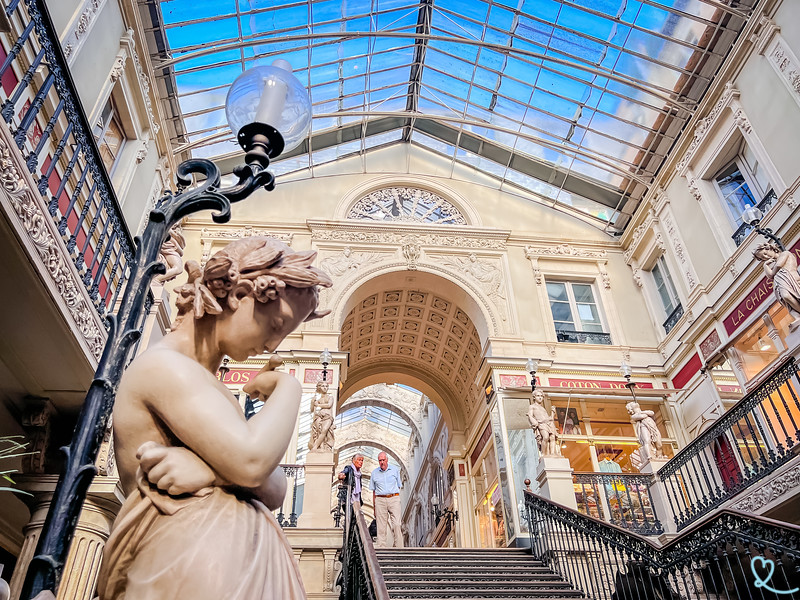
Visits






